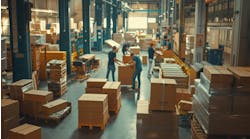Within today’s complex and increasingly transparent supply chains, there is always room for sustainability improvements. Trends in technology, visibility and automation feed the need for companies to operate efficiently, cut costs and reduce environmental impact.
Research shows corporate social responsibility is top of mind. Nearly 81% of Standard & Poor’s 500 companies prepared annual sustainability reports in 2015, according to Governance & Accountability Institute. Similarly, the latest Carbon Disclosure Project Supply Chain Report shows that manufacturers, suppliers and distributors are focusing on their overall environmental impact. The CDP report, however, also shows room for improvement. Of the suppliers surveyed, 36% noted having insufficient data to track.
This pressure to increase supply chain sustainability is causing companies to scrutinize their entire supply chain to uncover solid waste, energy and carbon emissions reduction solutions. This leads to a massive puzzle that seems impossible to face—and measure. Luckily, quantifiable solutions to environmental responsibility are available and go hand-in-hand with enhancing efficiency.
Understanding Reusables
Companies are looking to more sustainably manufacture their products but need numbers to measure how system adjustments, such as transitioning to reusable packaging, can positively impact their businesses. Reusable packaging is an example of both a sustainable and efficient problem-solver. In short, reusable packaging is used repeatedly to move, store and distribute products throughout the supply chain, improving product flow in an environmentally-friendly way.
Reusables come in a variety of packaging types, including totes, bins, pallets, divider sheets, bulk containers and protective dunnage.
Measuring the Impact
The need to justify and measure a sustainability initiative can be addressed with environmental analysis tools that use lifecycle analysis data to evaluate and compare single-use packaging and reusable packaging. This analysis uses real-time data from a given application and calculates unbiased environmental impact, in terms of greenhouse gas emissions, solid waste and energy usage.
Three steps of the lifecycle analysis determine the approximate impact a reusables program will have on a supply chain:
1. Analyze your application: The type of product, its shape, weight, volume, number and distance of trips, lifecycle, inventory velocity, storage needs, shipment frequency, end-of-life plan, protection requirements and turnover rates are assessed first.
2. Evaluate and compare packaging options: Multiple packaging options are identified.
3. Use the data to make decisions: Data is calculated to determine the environmental impact of converting from single-use packaging to reusables.
Quantifying the Value
With this type of unbiased data, companies can make informed decisions about their packaging. It also gives companies insight into their supply chain and opportunities to make waste reduction changes. Perhaps it means adjusting fill rates or changing the number of trips to gain more environmental benefits with reusable packaging.
With this analysis, users see unbiased results and can make the best business decisions to meet their requirements.
Knowing What to Expect with Reusables
Designed for reuse, the operational benefits of these products are also almost instantly understood after the right packaging combination is engineered and implemented. Though a large part of sustainability is preserving natural resources where possible, agility and a streamlined workflow can reduce waste throughout the supply chain—not only solid waste but also waste related to excessive walk-time, rework and dwell time.
Additional benefits of reusables include:
Longevity: Reusables with a long service life, such as plastic pallets, can be used for more than 100 trips, replacing packaging that is used once or twice.
Improved product flow: The standardized and lightweight reusable design allows products to travel safely and efficiently throughout the supply chain, including automated systems. Reusables are a consistent packaging solution that also will minimize downtime in automated and high-speed processing systems.
Lower packaging costs: Reusables reduce or eliminate the need for paper, plastic bags and other expendable packing materials. This decreases labor steps in the packaging process, reduces ordering and setup time, and requires almost no packaging disposal cost.
Decreased transportations costs: Reusables often nest or collapse when empty to allow more storage space in transportation and warehouses. These features also allow a truck’s maximum capacity to be met and transportation costs to be reduced.
Less waste: The waste of single-use packaging can be reduced significantly with reusable packaging that lasts multiple turns. And, at the end of its useful life, it can be recovered, recycled and reprocessed into new packages without entering the solid waste stream.
Evaluating the Fit
Every application is different, so a thoughtful system analysis helps companies determine if reusables will be effective for them. Understanding the entire supply chain is imperative in deciding if reusables are a sustainable and efficient solution. Among other things, tightly controlled closed loops or well-managed open-loop shipping systems with reverse logistics are ideal setups for reusable packaging.
Reusables also should be considered when:
• Current assembly or picking operations are complicated and require multiple touches.
• Product damage rates are high.
• There is a high part-usage and inventory velocity rate.
• Trailer space is underutilized in transportation.
• Waste disposal costs are high.
• Concerns about clean environment or part cleanliness/hygiene are present.
• Line space or picking aisles need to be optimized.
• Improvements can be made to worker safety and ergonomics.
Reusable packaging can bring long-term cost savings to many industries, including automotive, food and beverage, consumer packaged goods, electronics and pharmaceutical. Whether it is with reusable packaging or not, supply chain systems are dynamic and the packaging programs that support them must evolve. We see this with the need to be more sustainable, visible, data-driven and customer-focused.
If reusables are part of your evolution, experienced reusable packaging providers can help with every step of the lifecycle assessment. From analyzing the application, engineering the right packaging combination to designing and implementing the entire program and measuring/tracking its impact, you don’t have to complete the sustainability puzzle alone.
Christopher Shepard is sustainability lead at ORBIS Corp., a provider of reusable packaging solutions.




